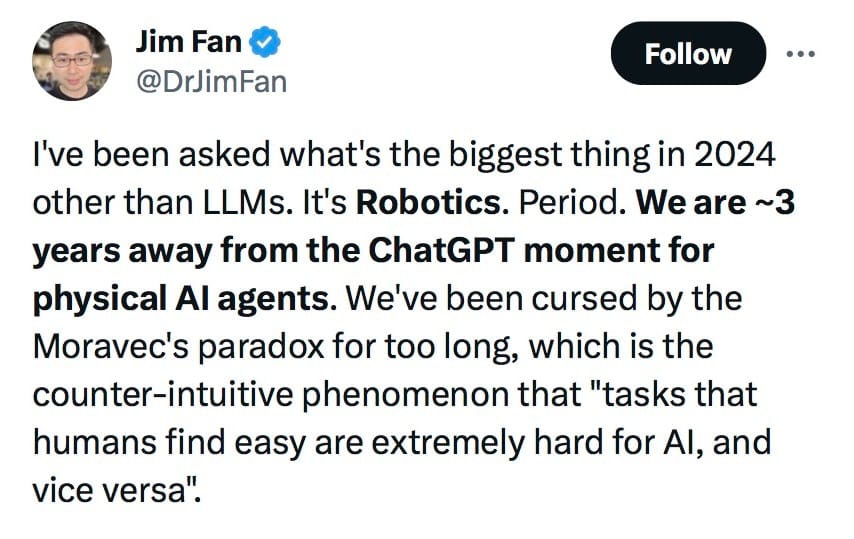The Next Frontier: Robotics as the New Revolution
In a world increasingly enamored with artificial intelligence, particularly with the emergence of Large Language Models (LLMs) like ChatGPT, it's easy to overlook other technological revolutions simmering on the horizon. Dr. Jim Fan's recent proclamation, declaring robotics as the next significant technological upheaval for 2024, is a sharp reminder of this often-shadowed frontier.

During a visit to the Gundam Factory in Yokohama, Japan, earlier this year, the potential of robotics crystallized for me in a profound way. This complex, home to a moving, 59-foot-tall Gundam "mech," epitomizes the surreal potential of robotics.
It's an illuminating demonstration of robotics' future, even if we don't currently need gigantic robots. In Japan, where innovation meets audacity, startups are already selling 14-foot Gundam-like robots, making what once seemed like pure fantasy increasingly tangible.

WTF?
But what exactly would constitute the "ChatGPT moment" for robotics? This would be a seminal breakthrough or a transformative period where robotics technology becomes as accessible, versatile, and impactful as LLMs. Here's what this moment might encompass:
Widespread Accessibility: Echoing the democratization seen with ChatGPT, this robotics revolution would make sophisticated robots, from personal household robots to small business applications, accessible to the masses.
Advanced AI Integration: These robots would be embedded with AI systems adept at understanding and executing complex human tasks, mirroring how ChatGPT processes language.
Human-like Interaction: The robots would excel in engaging with humans, interpreting verbal and non-verbal cues, thus offering intuitive and user-friendly interfaces.
Versatility in Application: Similar to ChatGPT's diverse applications, these robots would be adaptable and able to perform tasks ranging from domestic chores to intricate industrial functions.
Learning and Adaptation: They would learn from their environments, enhancing their functionality over time, much like how machine learning models evolve.
Ethical and Safe Design: The design and programming of these robots would prioritize ethical considerations and safe human interactions.
Seamless Integration into Daily Life: Just as smartphones have become ubiquitous, these robots would become an essential part of everyday life, offering a more interactive and physical presence.
Collaborative Work with Humans: In professional settings, these robots would augment human productivity and creativity, complementing rather than replacing human workers.
Customization and Personalization: Users would have the opportunity to tailor these robots to their specific needs and preferences.
Global Impact: This breakthrough in robotics would have a far-reaching impact, potentially revolutionizing fields like healthcare, education, and environmental conservation.
This vision melds the rapid progress in AI, machine learning, sensor technology, and material science, hinting at a future where robots transcend their role as mere tools to become partners in enhancing human capabilities and experiences.
The robotics revolution, as with any technological advance, will require careful navigation, balancing innovation with ethical considerations. Yet, the potential for positive transformation is immense, promising a future where robotics not only complements but elevates the human experience.

Member discussion